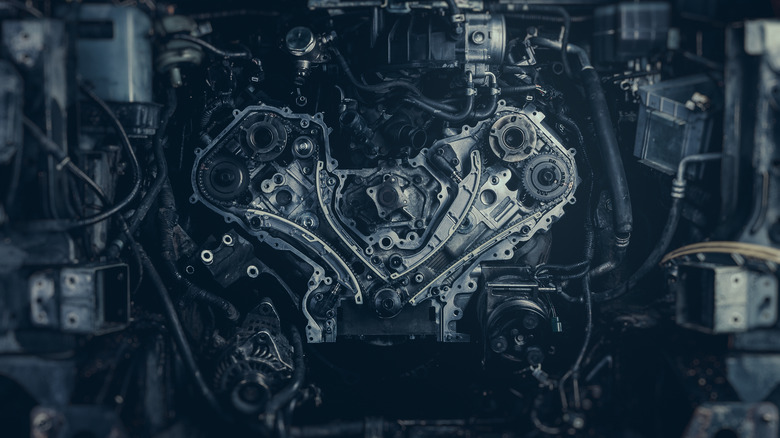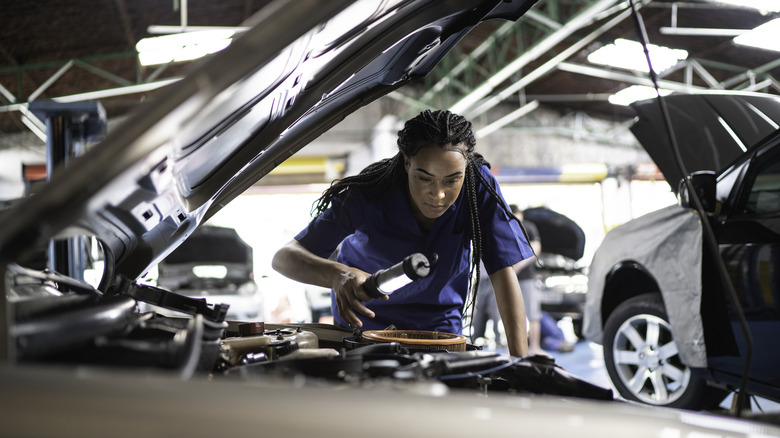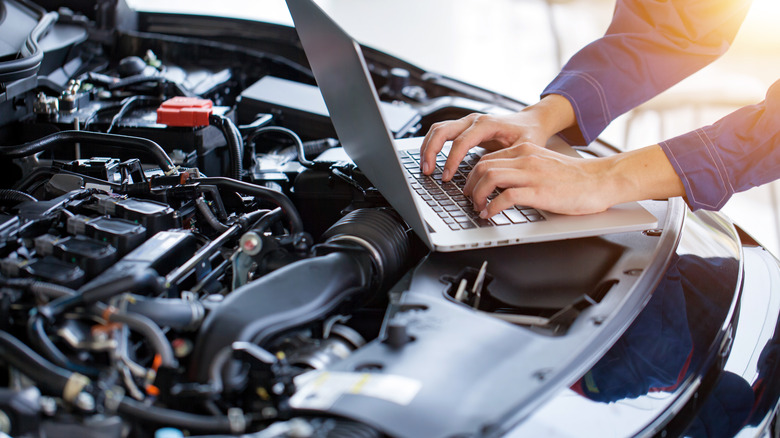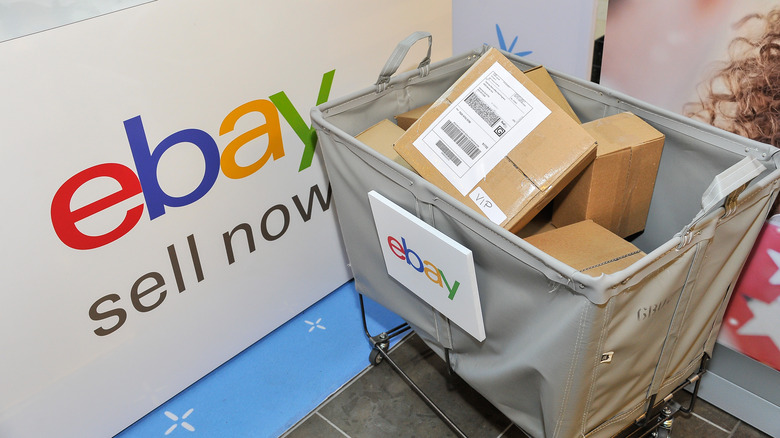5 Things To Know Before Buying A Used Engine On eBay
It's no secret that an engine is one of the most expensive components in any car, if not the most expensive. It's the heart of the vehicle, the vital part that makes the entire thing work; you literally can't drive without one. Because of this, there's unfortunately not much in the way of wiggle room when it comes to buying a brand-new engine. If you order directly from the manufacturer, it's going to cost you a proverbial arm and leg; there are no two ways about it.
If you can't deal with the heavy pricing from a fresh engine, though, there is an alternative: used engines. Much like most other car parts (or consumer products, for that matter), there's a network of individuals looking to sell their second-hand engines or remanufactured engines from junked cars for a healthy fraction of what they'd normally cost. For an extra layer of convenience, you can even find these used engines on eBay for bidding and purchasing.
As with anything you consider purchasing on eBay, though, a used engine must be viewed with an appropriate level of scrutiny and skepticism. There are, unfortunately, plenty of horror stories out there of individuals purchasing used engines on eBay only to find them completely nonfunctional upon receipt. To prevent this nightmare scenario, it's on you to gather as much information as possible to make an informed judgment before sending a stranger your money.
Determine what kind of engine you need
This might seem obvious, but it's always worth reiterating: not all engines are created equal. You can't slap a souped-up Ferrari engine into a little smart car, and you can't stick a tiny lawnmower engine into a massive pickup truck. Before you can even consider purchasing a used engine on eBay, you need to know exactly what kind of engine you're looking for so you can either find an identical model or at least get as close to it as possible.
eBay actually has a system to aid in this endeavor: the eBay Motors Parts Finder. eBay Motors is the platform's dedicated spot for vehicles and vehicle parts, so you should visit the front page to begin your engine hunt. Using the Parts Finder, you can input your car's make, model, year, trim, and other relevant information to automatically filter out any irrelevant listings and hone in on parts that are directly compatible. Any information you input is saved to My Garage, so you can quickly check it again later.
When searching with the Parts Finder, you'll be automatically directed to any exact matches for your specific vehicle. If there aren't any exact matches available, you may get some similarly worded listings, but those should be treated with a little extra skepticism.
Read eBay's purchasing protections
In the decades since its creation, eBay has taken more steps to protect users from scammers. In the specific case of cars, eBay offers Guaranteed Fit, a policy that stipulates any purchased automotive part will fit your vehicle perfectly and be in full functioning order. If the part either doesn't fit or doesn't work, you are entitled to a full refund. Before you take that at face value, though, you should carefully read over eBay's Money Back Guarantee rules. Not all purchases, even those of faulty items, are eligible for a full refund, even with Guaranteed Fit.
First, the purchase must have been made with an eligible form of payment, including credit cards, PayPal, Apple Pay, and any other form of payment made through eBay itself. If you made the payment outside of eBay, such as with a direct bank transfer, it can't help you (and you really shouldn't be doing that anyway). Similarly, the item must have been delivered to you directly by an eBay-authorized delivery method. Third-party pickup services and couriers are not covered. Finally, all refund requests must be made within 30 days of delivery. Consider that a good reason to test any purchased engines immediately.
Look for reputable sellers
Unlike shopping on Amazon, which deals primarily with authorized resellers, eBay sellers are usually individuals, either reselling their own possessions or specializing in a particular kind of product. Either way, if you're thinking of purchasing a used engine from an eBay seller, you first need to verify that this person is reputable.
The first step in verifying a seller is to check their feedback score, displayed as a percentage beneath their username on a listing. The higher this percentage is, the more users have reported positive experiences purchasing from them. Ideally, you want a seller with a feedback score in the mid to high '90s. If you click on the feedback score, you can see a seller's detailed ratings, which list user feedback on things like the accuracy of product descriptions, shipping costs and speed, and openness to communication in the event of a problem or concern. Again, higher scores, preferably from a large number of users, indicate a seller that deals in quality goods and makes sure everyone gets what they're looking for.
You can also check those detailed ratings for direct user feedback, both on the particular item you're looking at, if the seller has sold it before, and on their general listings. Keep a close eye on this section — if every piece of positive feedback is from the same buyer, this seller may be fraudulent.
Carefully read all relevant item information
Even if a seller has good ratings and is offering exactly the kind of engine you're looking for, you should still treat the listing with a healthy level of skepticism. This means carefully reading over the product description and inspecting the product photos for any signs of outdated information or falsification. If you've got any skills as a proofreader, this will be the time to put them to work for you.
For the description, more information is always a plus. You want as many specifications on the engine as possible, including its displacement, fuel type, compatibility, and so on. No piece of information is too small because every little factoid is something you can compare against what you already know about your vehicle. If there are any obvious mismatches in information, that's grounds for suspicion. Additionally, you should be wary of any misspellings or grammatical errors in the description. Anyone who's looking to sell something as expensive as an engine can spare five minutes for a spell check; if they didn't bother, they're not worth dealing with.
For the pictures, there should be multiple images of the engine, taken from multiple angles to give you a complete overview of it and its current condition. If there's only a single, low-resolution photo, there's almost definitely something the seller doesn't want you to see out of frame.
Check for seller warranties
Even if you're feeling pretty confident about a seller's authenticity, it won't hurt to have an extra layer of protection in case something goes wrong. This is why all eBay sellers have the option to offer a personal warranty on any products priced at over $15, which an engine obviously would be.
If a product listing for a used engine is advertised to have a warranty, either the complete contents of that warranty must be readily available within the listing itself, or there needs to be clear instructions on how and where to obtain a copy of the warranty. If the listing just says, "There's totally a warranty, don't worry about it," you should definitely worry about it. Similar to eBay's Money Back Guarantee, any warranties must be offered by eBay itself to be officially recognized. If the seller tells you in a direct message that there's a warranty, and there ends up not being one, eBay won't be able to do anything about that.





